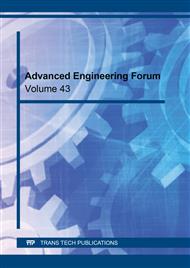[1]
Riccardo Mereu, Stefano Passoni, Fabio Inzoli. Scale-resolving CFD modeling of a thick wind turbine airfoil with application of vortex generators: Validation and sensitivity analyses. Energy 2019; 187:115969.
DOI: 10.1016/j.energy.2019.115969
Google Scholar
[2]
Siti Nurul Akmal Yusof, Yutaka Asako, Nor Azwadi Che Sidik, Saiful Bahri Mohamed,Wan Mohd. Arif Aziz Japar. A Short Review on RANS Turbulence Models. CFD Letters 2020, Issue 11: 83-96. https://www.akademiabaru.com/submit/index.php/cfdl/article/view/2267/1249.
DOI: 10.37934/cfdl.14.4.91117
Google Scholar
[3]
P. Catalano, D. de Rosa. RANS simulations of transitional flow by γ model. International Journal of Computational Fluid Dynamics 2019; 33 (10): 407–420.
DOI: 10.1080/10618562.2019.1684476
Google Scholar
[4]
Shengyi Wang, Derek B. Ingham, Lin Ma, Mohamed Pourkashanian, Zhi Tao. Turbulence modeling of deep dynamic stall at relatively low Reynolds number. Journal of Fluids and Structures 2012; 33: 191–209.
DOI: 10.1016/j.jfluidstructs.2012.04.011
Google Scholar
[5]
Ali Mosahebi, Eric Laurendeau. Introduction of a modified segregated numerical approach for efficient simulation of γ-Reθt transition model. International Journal of Computational Fluid Dynamics 2015; 29 (6-8): 357–375.
DOI: 10.1080/10618562.2015.1093624
Google Scholar
[6]
Mohammad Moshfeghi, Ya Jun Song, Yong Hui Xie. Effects of near-wall grid spacing on SST-K- ω model using NREL Phase VI horizontal axis wind turbine. Journal of Wind Engineering and Industrial Aerodynamics 2012; 107-108: 94-105.
DOI: 10.1016/j.jweia.2012.03.032
Google Scholar
[7]
Ph. Devinant, T. Laverne, J. Hureau. Experimental study of wind-turbine airfoil aerodynamics in high turbulence. Journal of Wind Engineering and Industrial Aerodynamics 2002; 90: 689–707.
DOI: 10.1016/s0167-6105(02)00162-9
Google Scholar
[8]
Chi-Jeng Bai, Wei-Cheng Wang. Review of computational and experimental approaches to analysis of aerodynamic performance in horizontal-axis wind turbines (HAWTs). Renewable and Sustainable Energy Reviews 2016; 63: 506-519.
DOI: 10.1016/j.rser.2016.05.078
Google Scholar
[9]
H. Sogukpinar, I. Bozkurt, M. Pala, H. Turkmenler. Aerodynamic Numerical Testing of Megawatt Wind Turbine Blade to Find Optimum Angle of Attack. International Journal of Engineering & Applied Sciences 2015; Vol. 7; Issue 4: 1-9.
DOI: 10.24107/ijeas.251260
Google Scholar
[10]
G.M. Ibrahim, K. Pope, Y.S. Muzychka. Effects of blade design on ice accretion for horizontal axis wind turbines. Journal of Wind Engineering and Industrial Aerodynamics 2018; 173: 39-52.
DOI: 10.1016/j.jweia.2017.11.024
Google Scholar
[11]
Yusik Kim, Zheng-Tong Xie. Modelling the effect of freestream turbulence on dynamic stall of wind turbine blades. Computers and Fluids 2016; 129: 53-66.
DOI: 10.1016/j.compfluid.2016.02.004
Google Scholar
[12]
Hamed Sedighi, Pooria Akbarzadeh, Ali Salavatipour. Aerodynamic performance enhancement of horizontal axis wind turbines by dimples on blades: Numerical investigation. Energy 2020; 195: 117056.
DOI: 10.1016/j.energy.2020.117056
Google Scholar
[13]
ANSYS Fluent User's Guide, Release 15.0, November (2013).
Google Scholar
[14]
ANSYS Fluent Theory Guide, Release 15.0, November (2013).
Google Scholar
[15]
P. E. Smirnov and F. R. Menter. Sensitization of the SST Turbulence Model to Rotation and Curvature by Applying the Spalart-Shur Correction Term. ASME 2008; GT 2008-50480.
DOI: 10.1115/gt2008-50480
Google Scholar
[16]
F.R. Menter, R.B. Langtry, S.R. Likki, Y.B. Suzen, P.G. Huang, and S. Volker. A Correlation-Based Transition Model Using Local Variables: Part I - Model Formulation. ASME 2004; GT 2004-53452.
DOI: 10.1115/gt2004-53452
Google Scholar
[17]
P.R. Spalart and M.L. Shur. On the Sensitization of Turbulence Models to Rotation and Curvature. Aerospace Sci. Tech. 1997; 1(5): 297–302.
DOI: 10.1016/s1270-9638(97)90051-1
Google Scholar
[18]
M.L. Shur, M.K. Strelets, A.K. Travin and P.R. Spalart. Turbulence Modeling in Rotating and Curved Channels: Assessing the Spalart-Shur Correction. AIAA Journal 2000; 38(5).
DOI: 10.2514/3.14481
Google Scholar


